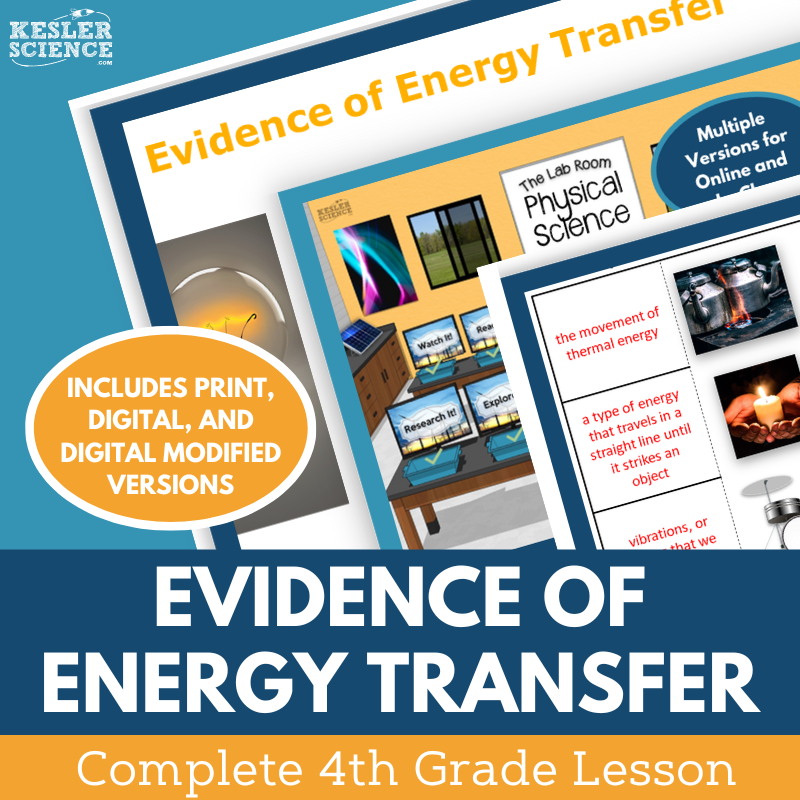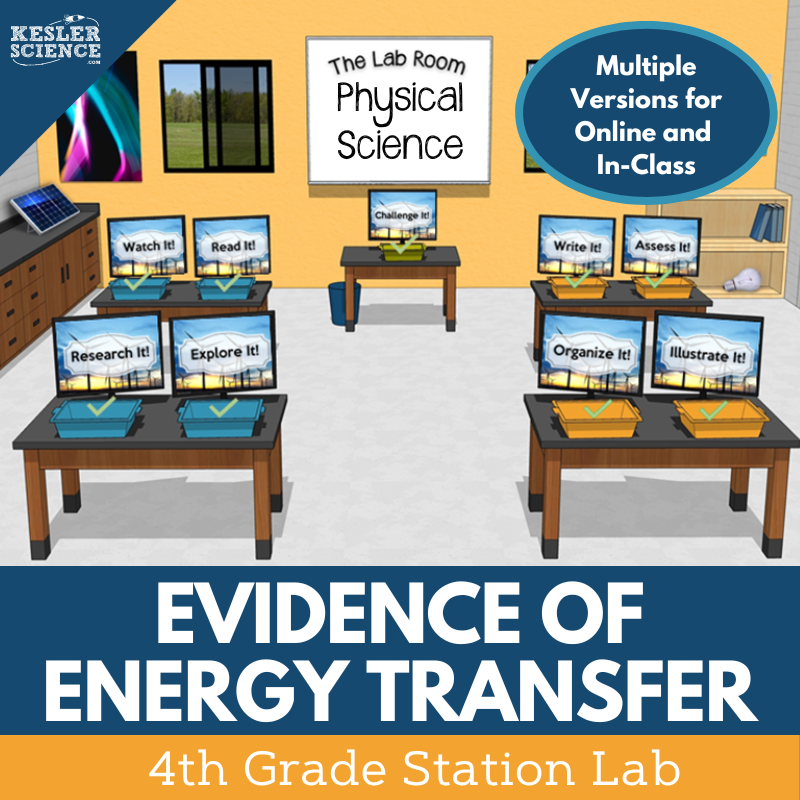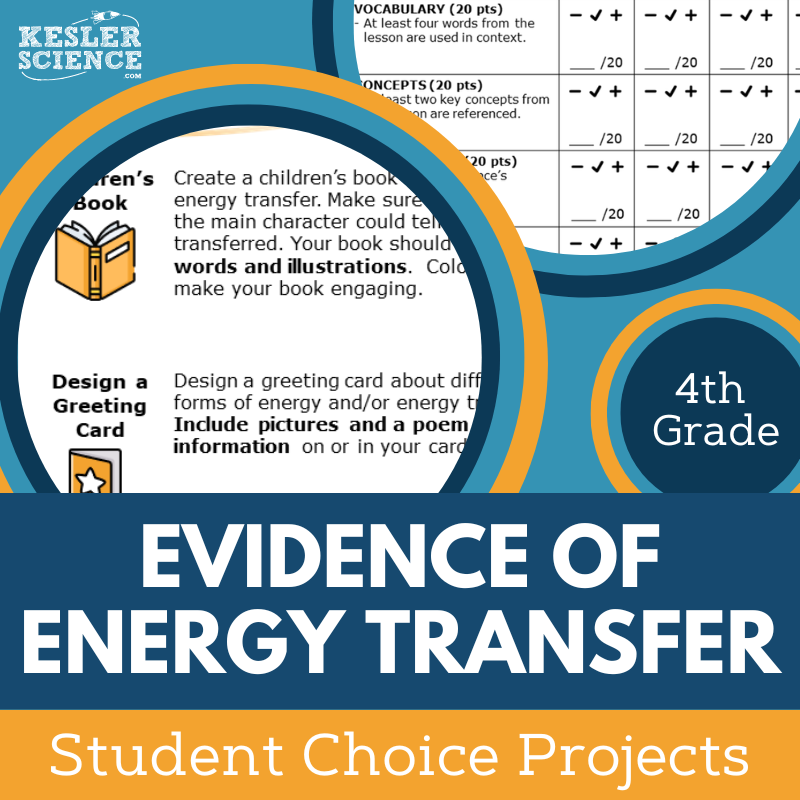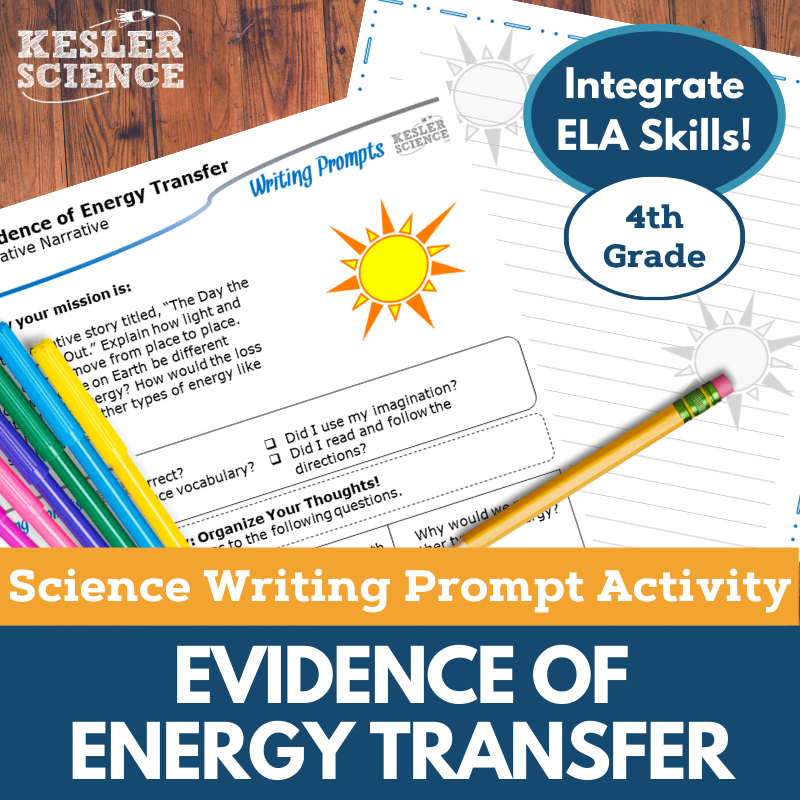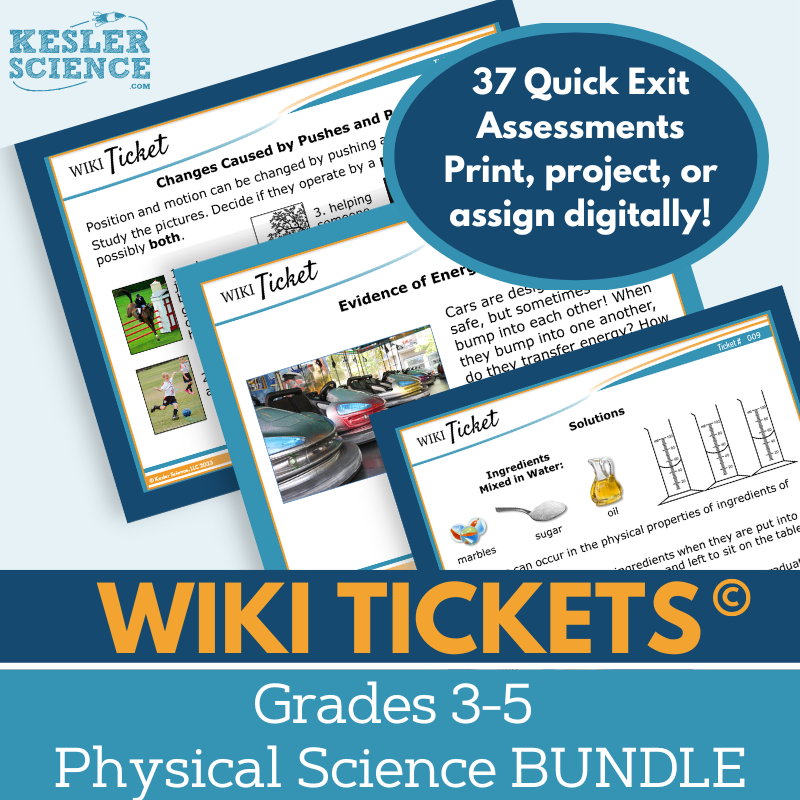Evidence of Energy Transfer Activities for 4th Grade Science
The Kesler Science Evidence of Energy Transfer resources provide engaging, standards-aligned activities that help 4th grade students explore how energy is transferred through sound, light, heat, and electric currents. The resources below will give students a comprehensive understanding of evidence of energy transfer. All of the following materials are also included in the Kesler Science Membership.
The Kesler Science Evidence of Energy Transfer 4th Grade Complete 5E Lesson simplifies lesson planning by providing all the materials needed for an engaging, multi-day lesson. With minimal prep and student-led learning, this resource focuses on helping students understand how energy is transferred between objects and how currents flow in circuits. The lesson is aligned with the 5E Model—Engagement, Exploration, Explanation, Elaboration, and Evaluation—ensuring comprehensive learning.
Students engage with the lesson through differentiated materials and multimodal learning formats, offering flexibility for both printable and digital formats. The lesson includes editable PowerPoints, Spanish translations, and a variety of activities across all five stages of the 5E Model. The Exploration section features a student-led station lab with nine differentiated stations, allowing students to explore energy transfer through experiments, readings, research, and videos. The output stations enable students to demonstrate their learning through hands-on activities, writing, and illustrations.
In the Explanation stage, teachers can use interactive PowerPoints and notebooks, providing additional opportunities for differentiation. The Elaboration section includes student-choice projects to extend learning, while the Evaluation stage offers assessments in multiple formats for diverse learning needs. Whether for in-class or virtual learning environments, this lesson supports both educators and students in mastering the evidence of energy transfer concept.
The Kesler Science Evidence of Energy Transfer 4th Grade Complete 5E Lesson simplifies lesson planning by providing all the materials needed for an engaging, multi-day lesson. With minimal prep and student-led learning, this resource focuses on helping students understand how energy is transferred between objects and how currents flow in circuits. The lesson is aligned with the 5E Model—Engagement, Exploration, Explanation, Elaboration, and Evaluation—ensuring comprehensive learning.
Students engage with the lesson through differentiated materials and multimodal learning formats, offering flexibility for both printable and digital formats. The lesson includes editable PowerPoints, Spanish translations, and a variety of activities across all five stages of the 5E Model. The Exploration section features a student-led station lab with nine differentiated stations, allowing students to explore energy transfer through experiments, readings, research, and videos. The output stations enable students to demonstrate their learning through hands-on activities, writing, and illustrations.
In the Explanation stage, teachers can use interactive PowerPoints and notebooks, providing additional opportunities for differentiation. The Elaboration section includes student-choice projects to extend learning, while the Evaluation stage offers assessments in multiple formats for diverse learning needs. Whether for in-class or virtual learning environments, this lesson supports both educators and students in mastering the evidence of energy transfer concept.
The Kesler Science Evidence of Energy Transfer Station Lab offers a dynamic, student-led learning experience for 4th grade classes, providing comprehensive materials that save prep time while allowing students to take charge of their learning. In this station lab, students explore how energy can be transferred through sound, light, heat, and electric currents, making observations to gather evidence of energy transfer.
Each station lab includes eight differentiated activities, allowing students to create a personalized learning experience, with a ninth challenge station for early finishers. The stations are modular, enabling independent or small group work, and providing resources like signage, literature, and task cards. The lab also includes materials for the Explore It! station, which can be used with common classroom supplies.
The nine stations feature a variety of input and output activities. Input stations offer multimodal ways for students to engage with new concepts, including experiments, readings, research tasks, and videos. Output stations give students the opportunity to showcase their learning through hands-on activities, illustrations, written responses, and assessments. The Challenge It! station provides additional opportunities for early finishers or advanced learners to expand their understanding. The lab is designed for both in-person and virtual learning environments.
The Kesler Science Evidence of Energy Transfer Station Lab offers a dynamic, student-led learning experience for 4th grade classes, providing comprehensive materials that save prep time while allowing students to take charge of their learning. In this station lab, students explore how energy can be transferred through sound, light, heat, and electric currents, making observations to gather evidence of energy transfer.
Each station lab includes eight differentiated activities, allowing students to create a personalized learning experience, with a ninth challenge station for early finishers. The stations are modular, enabling independent or small group work, and providing resources like signage, literature, and task cards. The lab also includes materials for the Explore It! station, which can be used with common classroom supplies.
The nine stations feature a variety of input and output activities. Input stations offer multimodal ways for students to engage with new concepts, including experiments, readings, research tasks, and videos. Output stations give students the opportunity to showcase their learning through hands-on activities, illustrations, written responses, and assessments. The Challenge It! station provides additional opportunities for early finishers or advanced learners to expand their understanding. The lab is designed for both in-person and virtual learning environments.
The Kesler Science Evidence of Energy Transfer Student Choice Projects allow 4th grade students to select from a variety of project options that align with their preferred output style. The project page offers six student-led project choices and a “design your own” option, with a flexible grading rubric that can be used by teachers, peers, or students themselves. These projects are adaptable, allowing teachers to modify the rubric to meet specific grading needs, while providing students with multimodal ways to express their understanding of energy transfer.
The Student Choice Projects include nine project options plus the “design your own” choice, along with teacher directions and editable rubric pages that assess vocabulary, concepts, presentation, clarity, and accuracy. These resources cater to a wide range of learning styles, ensuring that each student can engage with the content in a way that suits them best. For students needing remediation, the modified version includes three options targeted to provide extra support.
Designed to be flexible and practical, the projects can be completed with common classroom supplies such as paper, markers, and scissors, while some crafting materials may be useful for model-building. Many projects are also suitable for digital completion, making it easier to adapt for both in-person and remote learning environments.
The Kesler Science Evidence of Energy Transfer Student Choice Projects allow 4th grade students to select from a variety of project options that align with their preferred output style. The project page offers six student-led project choices and a “design your own” option, with a flexible grading rubric that can be used by teachers, peers, or students themselves. These projects are adaptable, allowing teachers to modify the rubric to meet specific grading needs, while providing students with multimodal ways to express their understanding of energy transfer.
The Student Choice Projects include nine project options plus the “design your own” choice, along with teacher directions and editable rubric pages that assess vocabulary, concepts, presentation, clarity, and accuracy. These resources cater to a wide range of learning styles, ensuring that each student can engage with the content in a way that suits them best. For students needing remediation, the modified version includes three options targeted to provide extra support.
Designed to be flexible and practical, the projects can be completed with common classroom supplies such as paper, markers, and scissors, while some crafting materials may be useful for model-building. Many projects are also suitable for digital completion, making it easier to adapt for both in-person and remote learning environments.
The Kesler Science Evidence of Energy Transfer Science and ELA Integrated Writing Activity provides 4th grade students with an opportunity to creatively demonstrate their understanding of energy transfer through writing a creative narrative. This engaging activity blends science and language arts, helping students deepen their scientific reasoning while enhancing their writing skills. Designed for virtual learning, the product ensures that 4th graders remain engaged regardless of the learning environment.
Aligned with TEKS and NGSS standards, this activity is low prep and versatile, making it a perfect tool for both elaboration and review. The prompt encourages students to think critically about energy transfer and express their knowledge through a creative narrative. The resource includes multiple formats to accommodate different learning environments, including digital and printable options.
The teacher guide includes detailed instructions, a rubric, and ideas for customization, while the student handouts provide ample space for writing and self-assessment. The resource is also adaptable for various uses, such as pre-tests, differentiation, or extra credit projects, and can be easily incorporated into interactive notebooks or journals. This flexible activity promotes creativity and student choice, fostering independent learning.
The Kesler Science Evidence of Energy Transfer Science and ELA Integrated Writing Activity provides 4th grade students with an opportunity to creatively demonstrate their understanding of energy transfer through writing a creative narrative. This engaging activity blends science and language arts, helping students deepen their scientific reasoning while enhancing their writing skills. Designed for virtual learning, the product ensures that 4th graders remain engaged regardless of the learning environment.
Aligned with TEKS and NGSS standards, this activity is low prep and versatile, making it a perfect tool for both elaboration and review. The prompt encourages students to think critically about energy transfer and express their knowledge through a creative narrative. The resource includes multiple formats to accommodate different learning environments, including digital and printable options.
The teacher guide includes detailed instructions, a rubric, and ideas for customization, while the student handouts provide ample space for writing and self-assessment. The resource is also adaptable for various uses, such as pre-tests, differentiation, or extra credit projects, and can be easily incorporated into interactive notebooks or journals. This flexible activity promotes creativity and student choice, fostering independent learning.
The Kesler Science Physical Science WIKI Tickets provide engaging formative assessments for 3rd–5th grade science. This set includes 37 exit tickets aligned to NGSS and TEKS, covering chemistry, energy, force, and motion topics.
Each assessment comes in five formats: a full-screen display for projection, three printable handout sizes, and an interactive digital version compatible with PowerPoint and Google Slides. A table of contents file ensures easy standard alignment.
WIKI Tickets (“What I Know Is”) serve as exit tickets, bellringers, or quick checks for understanding, making them a versatile tool for both in-person and virtual learning environments.
The Kesler Science Physical Science WIKI Tickets provide engaging formative assessments for 3rd–5th grade science. This set includes 37 exit tickets aligned to NGSS and TEKS, covering chemistry, energy, force, and motion topics.
Each assessment comes in five formats: a full-screen display for projection, three printable handout sizes, and an interactive digital version compatible with PowerPoint and Google Slides. A table of contents file ensures easy standard alignment.
WIKI Tickets (“What I Know Is”) serve as exit tickets, bellringers, or quick checks for understanding, making them a versatile tool for both in-person and virtual learning environments.
Year-Round Resources
These year-round activities will increase your students' understanding of many middle school science topics. All of these activities are also included in the Kesler Science Membership.
Visual Data & Graphing
You're not alone if your students struggle with understanding graphs, charts, and tables. It's a skill that takes an enormous amount of practice. This resource will help students build a strong foundation in analyzing data and creating their own data visualizations.
Bell Ringers and Warm-Ups
These middle school science bell ringers are an excellent way to engage your students as soon as they walk into your classroom. This comprehensive FULL YEAR resource includes everything you need to start off each science class with an interesting warm-up activity.
Review Board Games
Each game board has been carefully designed to keep students engaged. There are 10 different action spaces on each board and dozens of question cards. All of the actions are related to science concepts and keep the students motivated throughout the game.
Each game is ready to play. Simply print out the board and the cards and let the students enjoy reviewing nine different units.
Essential Questions
Below are the essential questions associated with the lessons and activities included in this unit. This topic is only one of more than 100 middle school science topics included in the Kesler Science Membership.
-
How does energy transfer from one object to another?
-
What is needed for a current to flow in a circuit?
Kesler Science Membership
Imagine never having to search for another middle school science lesson again. The membership gives you access to ALL of the Kesler Science products in one place (Yes, including everything above).
Say goodbye to long hours of lesson prep.

